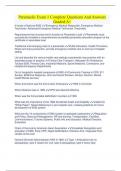Paramedic Exam 1 Complete Questions And Answers
Graded A+
4 levels of National EMS ✔✔Emergency Medical Responder, Emergency Medical
Technician, Advanced Emergency Medical Technician, Paramedic
Requirements that must be met to function at Paramedic Level ✔✔Paramedic must
successfully complete a comprehensive accredited paramedic education program at the
certificate or associates level
Traditional and emerging roles of a paramedic ✔✔Public Education, Health Promotion,
Illness and injury prevention, provide emergency medical care in and out of hospital
setting
List and describe the various health care settings a paramedic may practice with an
expanded scope of practice ✔✔Critical Care Transport, Helicopter Air Ambulance,
Tactical EMS, Primary Care, industrial Medicine, Sports Medicine, Corrections, and
Hospital Emergency Departments
Out of hospital/In-hospital component of EMS ✔✔Community Training in CPR, 911
Access, EMS/Fire Response, LEO and Social Workers, Nurses, Doctors, Mental
health/Rehab services
When and where was the first Civilian Ambulance ✔✔1860 in Cincinatti
What milestone was in 1960 ✔✔CPR was deemed effective
When was the first portable defibrillator invented ✔✔1959
What was the importance of the 1966 Accidental Death and Disability ✔✔Called the
"White Paper", Noted deficiency's in pre-hospital care, created guidelines for future
development of EMS system
What are the 10 components of EMS system to statewide assessment ✔✔Regulation
and Policy, Resource Management, HR and training, Transportation, Facilities,
Communications, Trauma Systems, Public info and education, Medical Direction,
Evaluation
Chain of Survival by American Heart Association ✔✔Immediate Recognition and
activation of EMS, Early CPR, Rapid Defibrillation, Effective ALS, integrated Post-
cardiac arrest care
General Services Administration-KKK-A-1822 ✔✔Type 1 Ambulance has no
passageway, type 2 raised van roof, type 3 passageway, type 4 heavy duty
, Level 1 Trauma ✔✔24/7 University Based, Comprehensive Stroke Center
Level 2 trauma ✔✔Primary stroke Center, 30 mins - 2 hour surgeon response time
Level 3 Trauma ✔✔Emergency Room
Primary Responsibilities of a Paramedic ✔✔Preparation, Response, Size-Up, Patient
Assessment, Treatment & management, disposition & transfer, documentation, Clean
up, Maintenance, Review
Additional Responsibilities of a paramedic ✔✔Community involvement, Support for
primary care, citizen involvement, personal and professional development
Professional Attributes of a paramedic ✔✔Leadership, Integrity, Empathy, Self-
Motivation, Professional Appearance/Hygiene, Self-confidence, Communication Skills,
Time Management Skills, Diplomacy in Teamwork, Respect, Patient Advocacy, Careful
Delivery of Service
Basics of Physical Fitness ✔✔Cardiovascular, Flexibility & Strength, Nutrition & Weight
Control, Freedom from addiction, Back Safety
Dietary Guidelines ✔✔Enjoy your food but eat less, eat more fruits, vegetables, eat less
sodium and sugar, avoid junk foods
Standard Precautions ✔✔PPE, Gloves, Goggles, Mask, N-95, Gown
Most important infection control practice ✔✔Hand-Washing, scrub for 15 seconds
Stages of Grief ✔✔DABDA, Denial, Anger, Bargaining, Depression, Acceptance
What are the responses to stress ✔✔Alarm, Resistance, Exhaustion
Good stress ✔✔Eustress
Bad Stress ✔✔Distress
Infectious disease caused how ✔✔By Pathogens
Greatest hazard to EMS ✔✔Motor Vehicle Collisions
Steps for Scientific Method ✔✔Observe, Data Collection, Construct Hypothesis, Test
Hypothesis, Analyze Results, Revise Hypothesis, Report Results




